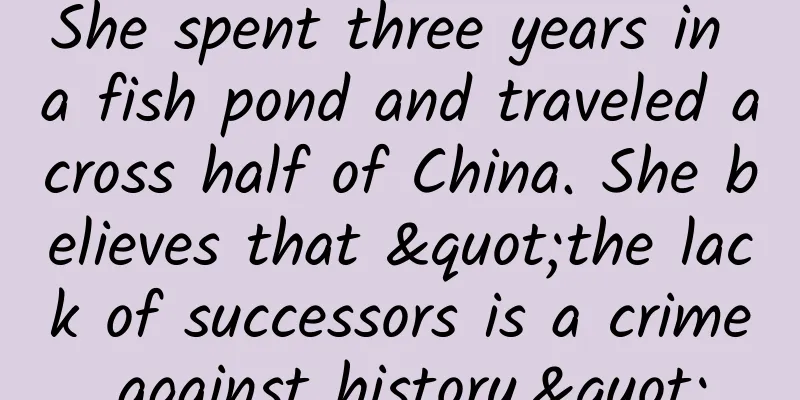Can this strange bronze "box" take us "directly" to the Shang Dynasty?

|
Whether it is the previous costume mythological TV series "Investiture of the Gods" or the recently popular mythological epic movie "Investiture of the Gods Trilogy", the magnificence of the Shang Dynasty palace is shocking, and the large number of exquisite scenes are also amazing. Were the Shang and Zhou Dynasty buildings more than 3,500 years ago really so luxurious and sophisticated? Let's take a look at this strange bronze component that goes "directly" to the Shang Dynasty and get a glimpse of the whole picture. The bronze "box" shows the luxurious style of the Shang Dynasty palace This bronze artifact looks a bit strange, like a "black box" and feels quite heavy. In the winter of 1989, the weather was cold. In Shifo Township, a suburb 20 kilometers northwest of Zhengzhou city, several farmers were digging the soil beside a threshing ground when they suddenly found this shabby "box". Its surface was rusty and had strange and curved lines. When they tapped it with their fingers, it made a metallic sound. They knew it was an antique, so they handed it over to the local cultural relics department. Experts have identified that the object is concave when viewed from above, with a nearly square front and inward-folded upper and lower sides; the left and right sides are nearly parallelograms, with a vertical rectangular hole in the middle. Because the shape and structure of this object are very different from bronze ritual vessels, weapons, chariots and daily utensils, and because a large rammed earth building foundation was found near the site where it was unearthed, it was inferred at the time that it should be a component inlaid on a building, hence the name "bronze building component with animal face pattern." According to the "Henan Provincial Cultural Relics Records", "In December 1989, bronze architectural ornaments were unearthed from the Xiaoshuangqiao site northwest of Zhengzhou city. They have unique shapes, regular workmanship, clear and exquisite patterns, and smooth lines. They are extremely rare fine bronzes from the early Shang Dynasty and are also the earliest bronze architectural ornaments discovered in my country so far." From the decorative pattern, the front of the vessel is a beast face pattern outlined with negative lines, and the beast face is composed of horns, eyes, nose and mouth. The beast face has huge horns, which are forked like deer horns; the eyes are wide open with the corners of the eyes raised, which is quite majestic; the long nose has large nose dimples drawn with double lines on both sides; the mouth is wide and sharp; the lines drawn with negative lines on the outside of the beast face are like cloud patterns and the whiskers of the beast face. The patterns on both sides of the artifact are similar, both of which are dragon and tiger fighting elephant patterns. The upper and right sides are a curved dragon pattern, which is similar to the snake pattern on bronze artifacts in the Shang and Zhou dynasties, with a curved body and a curled tail; the lines drawn with negative lines on both sides of the dragon body are like clouds or water, and can also be understood as deformed claws; the dragon head is composed of horns, eyes and nose, with clear contours, protruding eyes, and upturned corners of the eyes, which is quite angry. The lower side is a tiger pattern, with the tiger's mouth wide open in a swallowing state, the waist and back are bent, the tail is dragged down and slightly curled up, the limbs are short, and the claws and teeth are protruding, which is obviously in an attacking state. The left side is a pictographic pattern, with the elephant head under the dragon head and the tail in front of the tiger's mouth. The elephant head has a curled long trunk, the eyes are upside down, and the limbs are squatting. The body and tail are relatively abstract. The upside-down eyes and squatting limbs of the pictographic pattern can show the meaning of submission. The bronze building components with animal face patterns are not only decorations on the front of the wooden beams of the palace, but also components to reinforce the wooden beams. The overall layout of the decoration is rigorous, and the lines of the decoration are exquisite and delicate. It has a sense of solemnity and majesty, showing the splendor and luxury of the palace of the Shang king. It is called "Jinguan" and is an ornament of the palace for worshipping heaven in the Shang Dynasty. According to archaeological experts, this type of bronze building component was called "gāng" in ancient times. It is a ring-shaped metal decoration on the crossbeam between the walls of ancient palaces. Gāng can be divided into four types: inner corner, outer corner, middle section, and end. It is mainly used to connect the wooden frame of the house. It can be connected vertically or horizontally. It is generally used at interfaces and corners to play a reinforcement and decorative role. There should be a transition between the earliest binding connection and the later mortise and tenon connection in my country's wooden frame buildings, which may be metal connection. The bronze architectural ornaments are gorgeous on the outside but hollow on the inside. They should obviously be "lights" attached to large building components at that time. Ban Gu, a historian of the Eastern Han Dynasty, wrote in his Ode to the Western Capital: "Golden lanterns hold jade discs, which is a row of coins." Li Shan's note: "Lie coin is a golden lantern." Li Xian's note: "Lie coin means that a golden lantern is made of gold, with a jade disc held inside, and it is placed in the wall belt, forming a row of clear lines like coins." "Selected Works of He Yan": "Bright white, with coins lined up in a row." He Yan of the Three Kingdoms (Wei) wrote in his Ode to the Palace of Jingfu: "Bright white, with coins lined up in a row." "Golden lanterns" and "Lie coin" are gold rings inlaid with jade on the walls of the palace, arranged on a horizontal beam, like a string of coins, hence the name. According to architectural experts, the shape of the lantern is hollow and can be looped or attached to building components, playing the role of decorating and protecting building components. Coincidentally, bronze architectural components with exquisite patterns and designs have also been found in the Qin Palace ruins in Fengxiang, Xianyang, and the Qin Shihuang Mausoleum in Shaanxi Province. The largest number of unearthed bronze architectural components was found in the Qin Palace ruins in Yaojiagang, Fengxiang. Dozens of bronze components (golden lanterns) were unearthed in three batches. They are L-shaped, wedge-shaped, rectangular, and nearly square, with coiled dragon patterns cast on them. The ornaments prove that bronze architectural components were also popular among the Qin people, and they were used as decorations on the walls of the palaces. Above: Bronze architectural component with animal face pattern. Back view of a bronze architectural component with animal face patterns. Side view of a bronze architectural component with animal face patterns. The Xiaoshuangqiao site, where the bronze architectural components with animal face patterns were unearthed, is located on the south bank of the Yellow River. It is the only site with the scale and nature of a capital city discovered so far between the Zhengzhou Shang City and the Anyang Huanbei Shang City. According to Cui Junping, a volunteer guide at Zhengzhou Shang Dynasty Capital Site Museum, a large number of cultural relics have been unearthed at the Xiaoshuangqiao site, such as large palace sites, sacrificial sites, bronze smelting remains and red-lettered characters, reflecting the magnificence of the buildings in the past and the vicissitudes of the rise and fall of dynasties. In archaeological discoveries and academic discussions, it is being recognized by more and more scholars as the location of the "Xuan Capital". The Xiaoshuangqiao site is located in the southern suburbs of the Shang capital, Xiyi. The high platform building in it should be the altar for the Shang people to worship the heaven. The Shang Dynasty animal-faced architectural ornaments unearthed from the site are on the ground below and hollow above, used to erect wooden pillars for door pegs. The rectangular holes on both sides are used to pass through the threshold (now called the door sill). The patterns on the front and side can also be fully displayed. This device has a solemn shape and gorgeous patterns, which is suitable for installation in a prominent place in the middle of the palace gate. It should be a bronze lamp installed under the short pillar of the door peg in the middle of the palace gate at that time. Architecture, as one of the products of human practical activities, is also an important part of culture. China's wooden structure originated from the late primitive society and gradually formed a unique construction system after a long period of development. The bronze material came into being at the right time and was used as a component of wooden structure buildings. It not only played a decorative role, but also served a function similar to bracket sets. Before the appearance of bracket sets, it played an important role as a metal connector. Bronze culture has a long history. The bronze texture of the beast-faced Taotie, mythical animals such as the dragon, phoenix, and unicorn have long become symbols of Chinese culture through historical sedimentation. As important elements, they are used in (ancient) buildings and space decoration, becoming a beautiful landscape with rich heritage. |
Recommend
How to create product "growth power"?
Being able to demonstrate early growth is a key e...
WeChat "Search": How to layout keywords to grab traffic
On May 17, WeChat iOS users updated to version 6....
Deep understanding of Swift dispatch mechanism
Translator’s Note: I have read a lot about Swift&...
The latest news on Shanghai’s closure period in 2022: How many days will the closure last? When will the epidemic end and things return to normal?
Recently, new cases have appeared in Jilin, Changc...
How can bidding projects obtain promotion information through multiple channels? (Part 2)
Continuing from the previous article "How to...
WeChat 7.0.22 is officially updated! The features you want are finally here
Just last week, Apple iOS WeChat released an upda...
Pink pink pink pink...pink attack, are you ready?
The recently released "Barbie" created ...
Life Encyclopedia丨Do you store tea leaves at home correctly?
Tea is available in almost every household. As a ...
How do product managers bypass the iOS sandbox mechanism?
Let me first explain what the iOS sandbox mechani...
A brief history of operations: Understand the 20 years of development and evolution of Internet operations in one article!
Preface Operations is an interesting thing. As on...
iOS 16 "Real-time Activities" is adapted to Smart Island: display scores or takeaway progress, etc.!
The biggest update of the iPhone 14 series this y...
These major scientific and technological achievements were praised in the government work report.
On March 13, the two sessions of the National Peo...
Case analysis: Tencent advertising secrets!
Currently, the insurance industry’s advertising c...
Why doesn’t honey go bad?
This article was reviewed by Pa Li Ze, chief phys...
New changes in Internet subtitle groups may no longer be incompatible with copyright holders
If you are a fan of American dramas or Japanese a...









